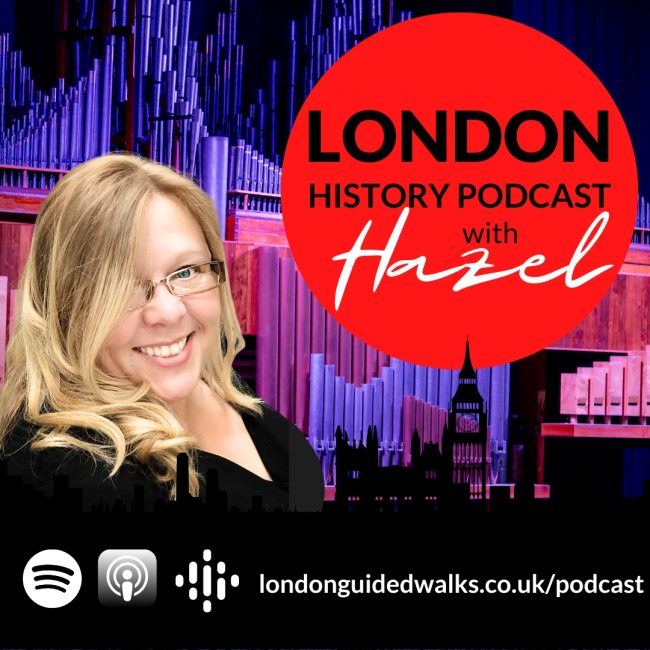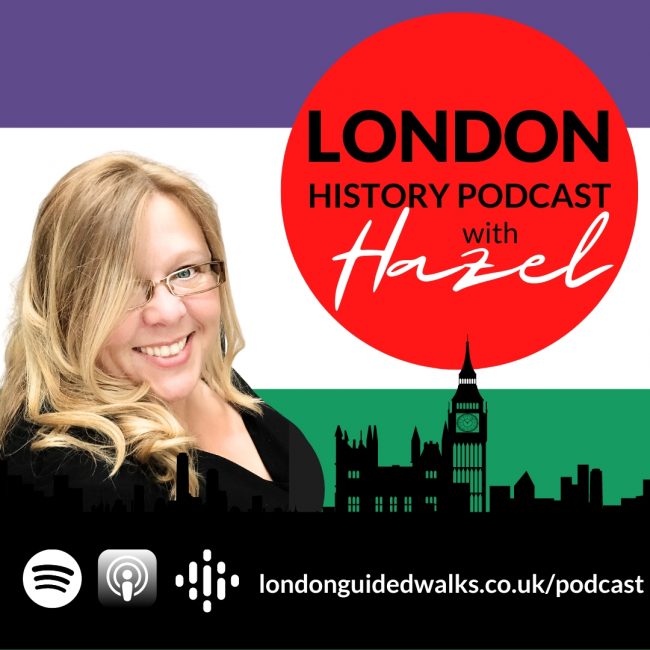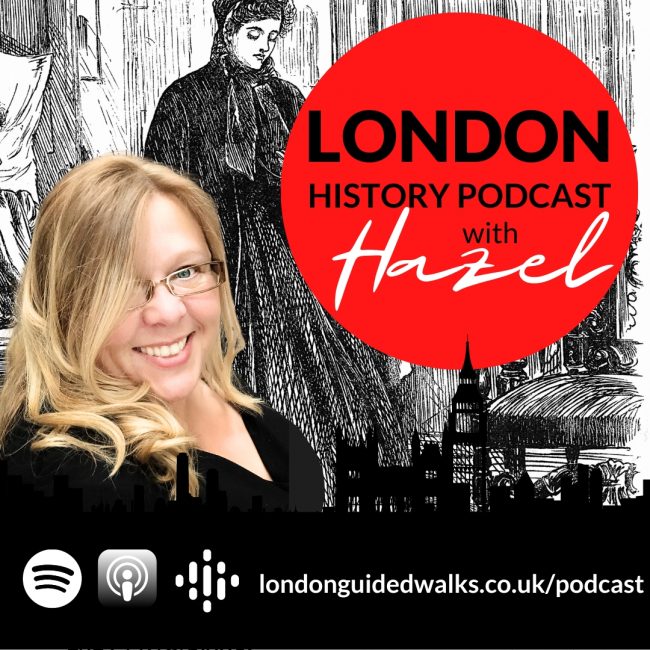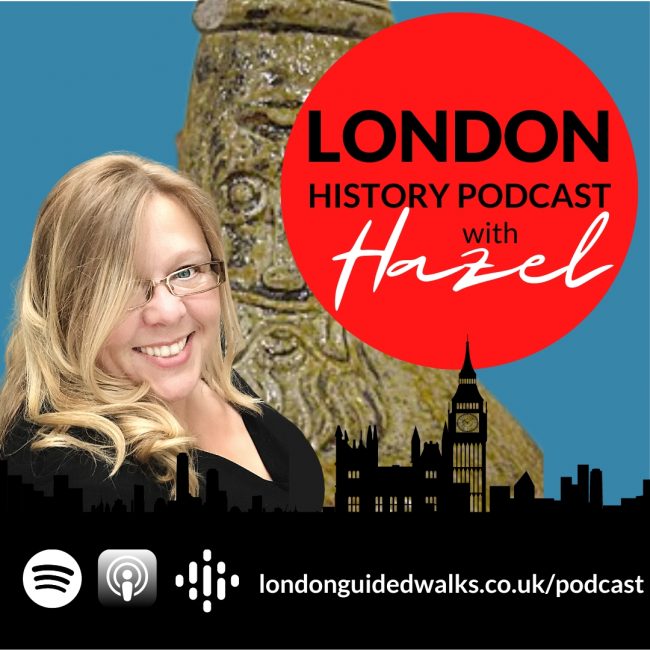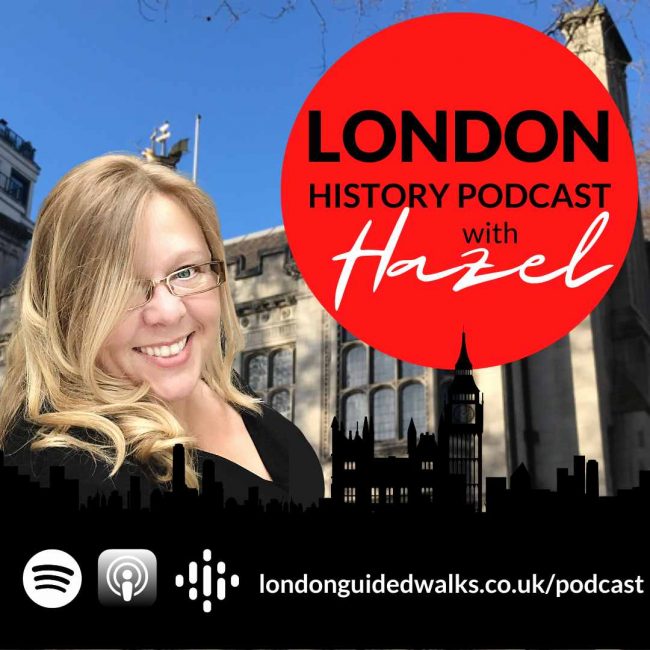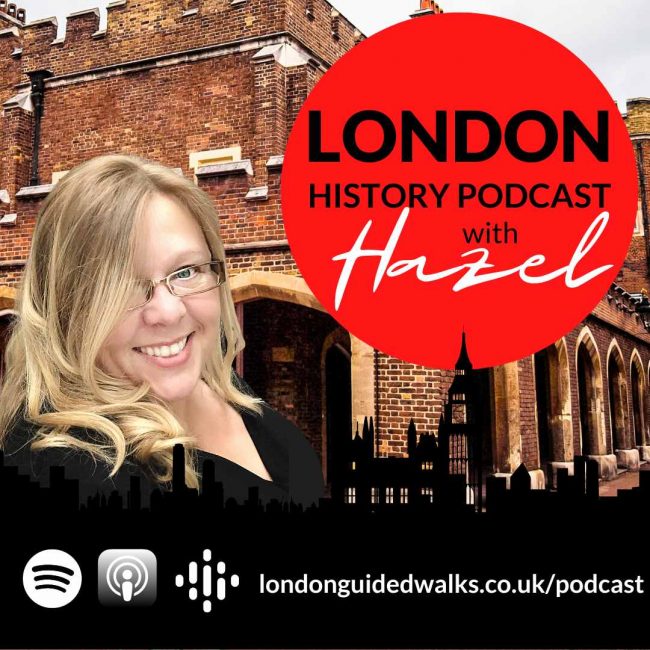Join us as we embark on a thought-provoking journey through the pages of London’s history, exploring the Transatlantic Slave Trade and the role that London played.
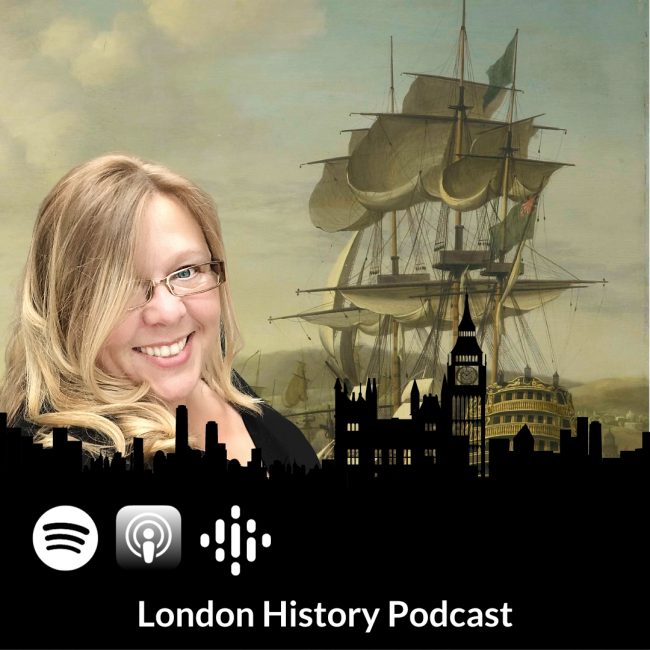
London Guided Walks » Episode 126: Transatlantic Slave Trade and London
Episode 126: Transatlantic Slave Trade and London

Host: Hazel Baker
Hazel is an active Londoner, a keen theatre-goer and qualified CIGA London tour guide.
She has won awards for tour guiding and is proud to be involved with some great organisations. She is a freeman of the Worshipful Company of Marketors and am an honorary member of The Leaders Council.
Channel 5’s Walking Wartime Britain(Episode 3) and Yesterday Channel’s The Architecture the Railways Built (Series 3, Episode 7). Het Rampjaar 1672, Afl. 2: Vijand Engeland and Arte.fr Invitation au Voyage, À Chelsea, une femme qui trompe énormément.

Guest: Ian McDiarmid
Ian McDiarmid qualified as a City of London tour guide in 2017 and has a particular passion for Roman and Medieval history, having in an earlier incarnation studied history at Cambridge and London universities.
He began working life in the early 80s in the City, and has since written extensively on the share and bond markets as a journalist. He loves talking finance and taking people around the narrow alleys where today’s massive trading centre was born.
When not walking and talking, Ian enjoys pottering about in the garden. His expertise is such that he often spends several hours doing this.
Reading List:
The Atlantic Slave Trade: a Census Philip Curtin
Black and British – a Forgotten History David Olusoga
The British Empire and the Atlantic Slave Trade 1660-1808 David Richardson in The Oxford History of the British Empire: The Eighteenth Century ed PJ Marshall
The Formation of Caribbean Plantation Society, 1689-1740 Richard Sheridan in The Oxford History of the British Empire: The Eighteenth Century ed PJ Marshall
The Slave Trade Hugh Thomas
Black Ivory James Walvin
Britain’s Slave Empire James Walvin
Transcript:
Hazel Baker: Welcome, dear listeners, to another fascinating episode of the London History Podcast, where we delve into the vibrant and diverse past of this great city. I am your host Hazel Baker, a qualified London tour guide and founder of londonguidedwalks.co.uk. Whether you’re a born and bred Londoner or a curious listener, join us on a journey through time as we explore the city together.
Each episode is supported by show notes, transcripts, photos, and further reading all to be found on our website. If you enjoy what we do, then you will love our guided walks and private tours that we offer throughout the year. All bookable online. At londonguidedwalks.co.uk. Subscribe now to never miss an episode, and if you enjoy the show, please leave us a review and rating to help spread the word to other history lovers.
PODCAST EPISODE 126: Transatlantic Slave Trade
- Transatlantic Slave Trade and London – 27:11:2023, 11.53
[00:00:00] Hazel Baker: Hello and welcome to our London History Podcast, where we share our love of London, its people, places and history. It’s designed for you to learn things about London that most Londoners don’t even know. I am your host, Hazel Baker, qualified London tour guide and CEO and founder of londonguidedwalks.co.uk. Each episode is supported by show notes, transcripts, photos and further reading, all to be found on our website. Click on londonguidedwalks.co.uk/podcast, and then select the episode that you fancy. And if you enjoy what we do, then you’ll love our guided walks and private tours that we offer throughout the year.
So get that cup of tea, put your feet up, and let’s begin. The story of the transatlantic slave trade is not one that can be told without acknowledging London’s integral part in this dark chapter of history. While we explore this topic, we’ll strive to maintain an educated, friendly and approachable tone, as we always do, and ensure that we remain neutral in our presentation of facts and narratives.
London, with its bustling docks, financial institutions and influential individuals, became a central hub for the transatlantic slave trade during the mid 17th century to the early 19th century. The city’s economy, Culture and society were intrinsically linked to the trade in enslaved Africans. As we explore this complex history, we’ll shine a light on the key figures who profited from the trade, as well as those who campaigned tirelessly against the institution of slavery.
Throughout this episode, we’ll seek to provide a comprehensive view of the Examining the economic interests, societal attitudes and the eventual abolitionist movement that emerged from London. Joining me in the studio is City of London tour guide Ian McDermid. He’s a regular on the show and a firm favourite.
So welcome back, Ian. We have missed you.
[00:02:13] Ian McDiarmid: Yeah, hello, Hazel. Yes, it’s been a while and it’s very good to be back. So thank you very much. And yes, I’m very, I hesitate to use the word enthusiastic because of the nature of today’s subject, which is slavery, but it’s one that I, and I’m sure many people find absolutely compelling.
[00:02:37] Hazel Baker: Slavery has been a part of cultures for many thousands of years. But this time we’re looking at the transatlantic slave trade in particular and the scale of the British involvement. And it was huge, wasn’t it Ian?
[00:02:52] Ian McDiarmid: Yes, this is one of the things about you, just putting it in context, because slavery was, sorry, pretty ubiquitous, I mean you could find it in most parts of the world.
Though on that point, one of the interesting things is that actually the one place where it is absent from the Central Middle Ages onwards to the beginnings of the period we’re going to talk about is It’s absent from Northwestern Europe, and one of the things that’s interesting is the kind of alacrity with which the European Atlantic powers, including Britain take up the trade.
But anyway, yeah, as you were saying, it’s absolutely huge. We’re talking in terms of the whole European involvement in it and the big… countries we’re talking about are Spain, Portugal, France, the Netherlands, and Britain, though other northern European countries are also involved on a small scale.
And it runs roughly from the early 16th century up until around 1870. And… The figures that I’m going to be using today, which I’ll be very grateful if you would help put in the bibliography, I’m going to be relying on figures by David Richardson, so we’ll put a little footnote in saying where those were, where the figures can be read.
But he’s working very much in the tradition of an American called Curtin, who first established the huge numbers, I think of the slave trade back in the 1960s. According to Richardson’s figures the, for the whole period, about 12 million are transported across from Africa to the Americas.
And of those 12 million, About 10 million make it to the other side and that. With regard to the British the British ship 3. 42 million and of those 3. 42 million, about 2. 96 million arrive on the other side. So it is absolutely massive. And the other striking thing about the British involvement in it is that compared to the other European powers, They are involved in this trade for a relatively short period.
So they come late to the phenomenon. British slaving really gets going about 1660. And then, of course, the British are the first nation to end it. They pass. Three important pieces of legislation, the most important is 1807, they end the transatlantic trade and then in 1833 and 1838, there are two pieces of legislation which abolish slavery in the British Empire and so 1662, 1807 is a shorter period than other slaving powers.
Within that period the British are the most efficient and they ship more slaves than anybody else. And a couple of points to, a couple of details to put in about the, these figures. One is that the overall mortality, when I say 3. 4, 42 million are shipped 2. 96 million arrive on the other side that equates to about a 13 percent mortality rate and the mortality rate declines over the period now probably almost goes without saying this has got nothing to do with humanitarianism it’s just that they get a bit more efficient at shipping what they would regard as their cargoes and in particular they’re using faster ships which cut down The time of the middle passage as it was known.
The other thing is that over this period as a whole, the volume of trading increases dramatically. Now the figures are very volatile. One of the reasons that they are volatile is that the slave trade is very vulnerable to periods of war. And there’s quite a lot of. warfare in particular with the French, but also with the Spanish.
And in the earlier period, in the 1660s, the British are transporting about 6, 700 a year. And that goes up to its peak in the 1760s when the British are transporting 42, 000 per annum.
[00:07:00] Hazel Baker: 42,000. That’s my hometown’s population.
[00:07:04] Ian McDiarmid: Yeah as ever with these statistics, they’re I think they’re the most important way of tackling the subject from the beginning, but it’s it’s very difficult to get into your head to actually try and imagine this, but absolutely, yes, absolutely vast.
[00:07:17] Hazel Baker: You might remember we had Michael Bunduck on episode 118 talking about Francis Barber, saying that one change in recent histography has been really to recognise the important presence of black people in Britain, especially London in the 18th century. It is also the case that there’s been recent re-emphasis on Britain’s role in, in slavery as well.
[00:07:48] Ian McDiarmid: Yes, and I think that this in part is a function of the way slavery is ended in this country. So you have the abolitionist movement, which leads to the ending of the trade. And once it is ended, the British become moral crusaders against slavery. And this. occurs perhaps in its first instance very early on.
So I was saying earlier that they don’t actually get around to abolishing slavery as an institution until the 1830s, but as early as 1815 at the Congress of Vienna, Castle Ray, British foreign secretary is instructed by the cabinet to put it, to insist on a provision in the treaty that the signatories give a commitment to the ending of slavery.
Now, this has. probably very little practical effect at all. But it’s interesting because it’s probably the first instance of a kind of preachy foreign policy that we would later associate with the Americans, in particular with Woodrow Wilson after the First World War, where you’re putting humanitarian general principles.
that are inspired by religion in part into foreign policy. And I think that one effect of this is that in the British collective memory, it was the abolition of slavery that was remembered rather than the institution. itself. And one of the things that I think will inevitably come up in talking about this is how deeply ingrained slavery was in so many aspects of British life.
[00:09:24] Hazel Baker: And what specifically was the role of London in all of this?
[00:09:30] Ian McDiarmid: Well, London is one of the three big slaving ports. So people, voyages are dispatched from a whole range of ports on Britain, including small ports and including Glasgow. But the three big ones that really dominate the trade and they are London, Bristol, and Liverpool, and London dominates the trade in the earlier period.
So from about 1660 to about 1730. And after that, Bristol has a brief period of dominance, and then it’s Liverpool. And at its peak in the period from 1720 to 1729, London sent out 600 slave ships, which accounted for 54 percent of the total. Slave voyages sent out by British shippers. And then as I said, at the end of the in, in the latter period the sort of dominance moves.
And at the end of the, our period when Liverpool is at its apogee in the 1790s, Liverpool sends out 1011 voyages. In that decade, London sends out 173 and Bristol 123, and in that decade, London is accounting for about 13 is accounting for 13 percent of the total of voyages. And the reason the sort of center of gravity shifts to the western ports is partly because bristol and to a greater extent liverpool are less vulnerable to french attacks than london is but also wages are lower in Liverpool.
The we’ll talk about the costs of slaving. They’re considerable paying for the crew is one of the big costs. And also they’re obviously very well positioned for Atlantic trade. thOugh London’s. importance, relative importance declines as the home for the the voyages.
It’s position in the overall slave trade remains very important in what we might describe as providing ancillary services. So most of the capital for the slave voyages comes locally. So we’re talking about partnerships of merchants and In the latter period, the Liverpool voyages are largely financed by Liverpool merchants.
But, London is crucial in two aspects of the kind of financing and organisation of voyages. One, London is the centre for the bills of exchange market. So we, I know we’ve mentioned bills of exchange in, in, in other podcasts. This is the… 18th and 19th century money market, the market for short term debt.
And in particular, the money market facilitates the short term financing of transatlantic trade. So merchants in the West Indies can issue bills of exchange and they can pay for things. They can borrow money short term and they can effect payments in London. London is also the center of the insurance market, which obviously is very important for the voyages.
And London merchants are also major suppliers of the goods that are then transported to Africa, which are then exchanged for slaves. And when we’re talking about the manufacturers going out to Africa, we’re talking, the most important ones throughout the period are textiles. And the nature of the textiles exported varies over the period.
So to begin with, it’s woolen cloth and cottons produced in India. Which then involves the East India Company indirectly in, in this commerce. And then in the later period, you’re getting the beginnings of the Industrial Revolution and it’s cottons produced in Lancashire which are then… Being transported out to Africa after textiles, the next most important class of goods is metals in general, followed by weapons.
And then there’s a whole range of miscellaneous goods. And within those kinds of sundry items, one of the very important ones is one that you. mentioned in an earlier podcast when you were doing the mudlarking on the Thames and you spoke a bit about glass beads being found in the mud and the export of glass beads to exchange for slaves was quite large and in the earlier period.
These glass beads come from Venice, and then it’s something that the Dutch take over and the Dutch produce a wider range of beads. They produce them in different sizes and they produce them in a greater range of colors than the Venetians. So it’s quite interesting to think, I remember you mentioning glass beads being dropped into the Thames mud and it’s interesting to speculate that perhaps they may have come from a a shipment that was ultimately destined to be exchanged for people in Africa.
[00:14:32] Hazel Baker: Yes, that was episode 112, Mudlarking, Georgian Finds.
[00:14:36] Ian McDiarmid: Yes, and actually, I’ve, sorry Hazel, I’ve just remembered something very important of is that the London merchants are also extremely important in handling all of the sugar that’s then brought in.
And we cannot really underestimate the importance of sugar in the 18th century economy. By about 1800 sugar accounts for about 25… 25 percent of the value of total British goods. So it’s sugar, but it’s also the, all the other goods that they’re sending out from the slave economies. The next and most important one is tobacco, but also things like rum and indigo.
[00:15:10] Hazel Baker: And what was it about sugar that sent us Brits so crazy for it?
[00:15:15] Ian McDiarmid: I think it’s a fairly, it’s not just the British. Everybody has a craving for sweetness and sugar becomes enormously important in all of Europe. But what I think is unique to Britain is that what to me standing back appears rather bizarre, that combination of Tea with sugar and that becomes obviously absolutely enormous and tea consumption begins as an aristocratic pursuit, but it rapidly descends throughout the lower rungs of society and becomes absolutely ubiquitous.
And indeed the sugar is probably an important part of the calorie intake of a lot of the. The laboring poor. So it’s that common, it’s that unique British institution of drinking sweet tea that really takes off in the 18th century.
[00:16:12] Hazel Baker: So we’ve been talking so far about trading in slaves, but what about the plantations as well?
[00:16:19] Ian McDiarmid: Yeah, so to give some idea of the scale of this, when slaving is abolished as an institution in the 1830s, there are 750, 000 slaves in British… that is to say in and around the Caribbean who are set free by this legislation. We need to obviously remember that in the 1770s and early 1780s, you have the American war of independence.
So prior to that the North American, Colonies were British, and there you’ve got plantations in the 18th century producing mainly tobacco. So we’ve got to remember all of those workers in those colonies that should be added to the total when considering the scale of it. And the British involvement in the Americas begins really in 1609 when they take Bermuda.
Shortly after that, they begin colonize, colonizing. The North America, North American seaboard beginning with Virginia and Massachusetts. 1625, the British take Barbados and then by the early 1630s, they’ve taken a few of the Leeward Islands, such as Antigua and Montserrat. And then 1655 is the big one in the Caribbean, big one in terms of its size Jamaica.
And what transforms all of this the British imperial presence in the Caribbean. is the introduction of sugar, and this looks as though it’s actually a product of Dutch involvement. So the Dutch had successfully conquered a large amount of Brazil. Brazil was a Portuguese imperial possession, but the Portuguese are successful in driving the Dutch out.
And when they leave. Quite a few of them move to Barbados in, in, in particular, and there they introduce Dutch methods of growing sugar. And also the Dutch I said earlier, the British only really get into transporting slaves in the 1660s. The Dutch are the kind of big carriers and in this earlier period, and they introduced the slaves to the Caribbean and It’s dramatic because the British had about 6, 000 slaves in the 1640s in the West Indies, and that increases to about 80, 000 in the 1660s.
And in the earlier period, they’re being used to grow tobacco. in the 1660s it’s sugar and this leads not just to a huge expansion in the slave population, but the value of the estates in the West Indies grows exponentially. And Hugh Thomas, who’s one of the sort of great writers on the transatlantic slave trade has a very good phrase for this.
He talks about the Caribbean as becoming the archipelago of sugar. And when it becomes the archipelago sugar, it’s the British and the French who are the dominant players. But it’s all made possible by the Dutch. And when we’re talking about the 18th century, and we’re talking about the face of the slaves being transported across around 70 percent of them are destined for the sugar plantations in the West Indies.
In this period the North American colonies are concentrating on tobacco and tobacco, the plantations are slightly smaller than they are in the West Indies. And it’s the. sugar cultivation that is the really harshest part of the slave system is where the mortality is highest. And in addition to producing sugar, they’re also producing by product of sugar is molasses and rum production is important, but it’s obviously the sugar.
That’s the main thing.
[00:20:12] Hazel Baker: And what about the wider economy? How did that all fit in then?
[00:20:15] Ian McDiarmid: Yeah it’s of enormous importance. So we’ve already talked about tea consumption. And when we’re talking about tea, we shouldn’t just be thinking about people consuming just the tea. It’s not… That’s the most important thing, but there’s also the paraphernalia that you associate with tea drinking.
So we’re saying that it began as an aristocratic thing. And we think of those fine porcelain sets, obviously even poorer house households are buying tea cups. teapots and the rest of it. So huge impact on ceramic industry. tHe other big crop after sugar is tobacco. And again, that has a similar kind of trajectory because by the 18th century even poor people.
are smoking. And coming back to mudlarking, just think of all those clay pipes, but also think of all the retailers of tobacco. And the slave economies are producing other products as well. They’re also producing, as I mentioned, indigo, but also rice are important. And we’ve got to think of all of those exports that are going to Africa.
It’s a huge part of British trade. A, an awful lot of British manufacturers are destined for that continent in the 1940s, there was a Marxist historian, Eric Williams, who postulated that the Industrial Revolution was actually financed on the back of the slave trade. That seems unlikely.
Richardson’s looking at. This he reckons that the typical return on a slave trade was around eight. To 10%. And if you manufacture that by the number, sorry, if you multiply that by the number of voyage voyages made you get a figure that’s insignificant in relation to the amount of capital that would, that was required for investment to get the industrial revolution going.
So that looks as though it wasn’t the case. But there is the obvious point that a lot of money was made out of this an eight to 10%. Return on the slaving voyages wasn’t bad. And then the income of the plantation owners in Jamaica, in good years in the 18th century, plantation owners could get a return of about 13%.
And obviously if you compound that it’s huge. The money that the plantation owners made was hugely volatile. and also there’s a process whereby the smaller estate owners are driven out and the, they become indebted and basically they’re taken over by the bigger estate owners, but nevertheless, overall, the wealth generated by these is fantastic.
And the one of the phenomena you get in Britain in the 18th century is that of the absentee plantation owner. These are people with new money, huge amounts of money, and they’re attempting to buy their way into the British elite.
[00:23:19] Hazel Baker: London was home to the Royal Africa Company as well. What was its role?
[00:23:24] Ian McDiarmid: Yeah, the, in the earlier period which coincides with London’s dominance Britain, like other European slaving Nations tries to organize the slave trade through chartered monopolies and the Royal African Company was the most important of the British companies. But all of the European slaving states try to set up basically what we might call state run monopolies.
And this begins in 1660 when Charles the second grants a thousand year monopoly of the, on the English slave trade to Africa to the company of royal adventurers trading to Africa. That company is then reconstituted in 1663. tHat indicates they got into a bit of trouble and nine years later. It’s right for transfer to the Royal African Company again for 1000 years and the Royal African Company had some success in particularly in the 16 eighties.
It manages to make some money and, but in 1698, it’s monopoly is. ended by Parliament and Parliament declares trade open to all merchants of the British Empire, provided that they pay 10 percent duty to the Royal Africa Company on their exports to Africa. And these duties then expire in 1712, after which the Royal Africa Company and its successor, the Company of Merchants Trading to Africa, their main role is to maintain the forts and factories in Africa.
And to summarize all that from 1698 onwards, the trade is dominated by private merchants rather than these organized companies. And the reason that they are so keen to have these organized companies is because you’ve the British state wants to tax the slave trade and it’s felt better if you’ve got a monopoly, you can do that.
But also they’re concerned with maintaining the forts and fortifications. And the idea is that if you’ve got a monopoly, they can use their monopoly to subsidize. Now the problem with the Royal African Company, and it’s a problem that’s suffered by all of the European attempts to run monopolies, is that they’re saddled with costs, the cost of maintaining these forts and fortifications, and they are indebted.
The other problem is that through, although they have a monopoly, there are always interlopers, and the interlopers are just so much more efficient, partly because they don’t have the costs of, maintaining these forts. And even when the RAC has a complete monopoly, an awful lot of the trade is in the hands of interlopers.
But the problems for them don’t stop there because a lot of the interlopers, i. e. the people breaking the monopoly, are actually employed by the Royal Africa Company itself. So the servants, as they were known as the company, would do trading on the side for their own accounts. And so the, these companies are never a great success.
And when its monopoly is ended in 1698, it’s really a recognition of, In a way, what has already become a fact that a lot of the trade has moved away from the Royal Africa Company. There are also lots of complaints from plantation owners that these companies, including the Royal Africa Company, are not delivering enough slaves to them.
And again, this reflects the fact that the interlopers, the private merchants are just so much more efficient at taking people across the Atlantic. Royal Africa company had its headquarters at Africa house. There’s a little bit of debate about where that was. Peep says that it was in broad street, but it may be that he was referring to the ward of broad street rather than the actual street.
So it may well have been just slightly to the north of the Bank of England.
[00:27:25] Hazel Baker: Now we’ve already done episode 27 about the South Sea bubble, but what else can we add to that?
[00:27:34] Ian McDiarmid: Yeah when we did the podcast we can basically sum it up by saying there are three parts of the South Sea Company.
One is an attempt to ship slaves to the Spanish Empire. The second is an attempt to refinance British government debt. And then the third aspect to it is this huge bubble in the share price, which bursts in 1720. So on the slave trading A lot of people within the British government get very excited towards the end of the War of Spanish Succession.
They are going to win big concessions from the Spanish and the French. And the concessions that the British get at the Treaty of Utrecht in 1713, they get Gibraltar, they get Menorca, which are both very important. Possessions. And the thing that perhaps it creates more excitement than those is they get the right to run the Asiento.
And the Asiento is the monopoly on shipping slaves to the Spanish Empire. So this is granted to the British as part of the peace treaty. And that Asiento is then sold to the South Sea Company. So the South Sea Company begins as a venture to ship slaves. hoWever, as we’ve already mentioned these chartered companies aren’t particularly efficient.
Part of the problem they’ve got is that their monopolies are hard to enforce. And the South Sea Company has the added problem is that the Spanish are never particularly cooperative in facilitating their trade. So they’re important in terms of The human misery of human slavery because they transport thousands of slaves, but then as a commercial success, it’s never particularly viable, the slaving part, and the company switches its attention towards the financial aspects of it.
But one of the things about the Southeast Company is that it’s fairly well documented, and… By the time 1770, early 1770, it raises money in the so called third money subscription. And okay, it’s principally concerned about financial operations at this time, but it’s still shipping slaves. And in 1720, the South Sea company.
Raises money now at this stage. It’s primarily focused on its financing operations, but it’s still involved enslaving and we have the lists of the subscribers to this capital raising and they very extensive the people subscribing for it amongst the so called great and good of British society.
So they comprise most of the House of Commons, about half of the House of Lords. Famously Thomas Guy, whose money then goes on to found the hospital. He actually makes money out of trading South Sea stock. He sells, he begins selling it when the share price hits 300 pounds. He sells his last shares at 600 pounds.
The share price carries on going up and hits 1, 000 pounds before crashing. Somebody else who… Got out as a good time was the Duchess of Kendal one of the King’s mistresses, but there’s also a long list of very famous British people who lost money on the shares. John Gay, the playwright, Vanbrugh.
tHe Duke of Portland, who had been William III’s favorite, was ruined by it. So the subscription lists show how widespread involvement in slavery was. And we should see, probably come onto this a bit later on, that investing in slavery in various ways was… in a way, just an obvious avenue for people with money to get some kind of what we would call portfolio diversification.
And they’re all pretty much all wealthy people are disposed, shall we say, to investing in, in slaving. So we’ve spoken about the Royal African Company. We’ve spoken about the South Sea Company and that both of these. Going to Klein and that most of the trade is carried on by private traders and we’re talking typically of partnerships financing these voyages of maybe six merchants and often sort of kinship ties are important in, in, in this but voyages would take a a considerable sum to fit out first of all, you have the ship itself and one aspect of the ships is that they are.
of short duration. A sailing ship would last no more than about 10 years. And within that time, it might make six voyages to Africa. In addition to financing the ship, you’ve also got to finance the crew. And the, an English ship would typically have a crew of about 30. The size of the British ships was limited.
They were typically between 100 and 200 tons, and one of the limiting factors in their size was that they needed to be able to work the African coast and also the estuaries of the rivers. Fairly easily, but using Richardson’s figures earlier on the big ones I was talking about and then dividing it by the total number of voyages, you arrive at an average of just over 400 slaves per voyage, according to his figures.
So I was saying that the voyages were typically financed by groups of merchants. Some of the One of the most prominent London merchants in the 1720s was Humphrey Morris, who was based in Mincing Lane. And in 1720 he had eight ships working for him. And these eight ships were named after his wife and daughters.
And he’s quite a good example of illustrating how, um, diverse this trade was. Normally when you read about it, it’s described as the triangular trade, and that’s a good description for a lot of the voyages. So triangular, because what would happen is that the ships would take manufactured goods out from England to Africa, trade them for slaves, who are then taken across the Atlantic, and then they return back to Britain, creating the third leg of the triangle, carrying sugar, but also the other products of the slave economy.
But what Morris was doing was that He was selling he was buying and selling slaves in Africa. So he would take ships to Africa. He would buy slaves and then he would sell them to Portuguese traders further along the coast. He did send some ships across the Atlantic, but he’s a kind of illustration of how how many.
diverse elements there were in this trade. Um, two of the other prominent merchants in the 18th century were Richard Oswald and John Boyd who both came from Scotland. And they are one of the interesting aspects of them is that they form along with other merchants. They buy Bunt’s Island. Bunt’s Island is an old RAC, sorry, Royal Africa company, fought in the mouth of the Sierra Leone river.
And it’s got a big holding pen for slaves and they buy that and they run that as a partnership from 1747. And John Boyd you can still see evidence of him because he built himself a fine house just outside London in what is now Bexley Heath. So Danson House Is this 18th century Palladian mansion, which was done up 15 or 20 years ago by English heritage and is run by the council and English heritage.
You can visit that today and it sits within Danson park, which is a kind of general park, but you can tell by looking at the park that is actually the landscape gardens for a house. And Boyd was also very well known for his collection of master pictures. And when you start looking for the connections with the slave trade, they are absolutely.
everywhere. So for example, if you go around the British museum, they have a little section on Hans Sloane, whose collection was one of the core elements within the British museum. And a lot of his money came from his wife and his wife was the heiress of plantations. There’s a very good exhibition currently on.
at the Bank of England Museum. Bank of England has a small museum. At the end of it, they’ve got a, an exhibition space now dedicated to the connections between directors of the Bank of England and the slave trade. And they include Robert Clayton who was a director of the Bank of England from 1702 to 1707.
He served on the board of the Royal Africa Company, and he was also, like a lot of these a lot of the prominent slave traders who we know today via statues and the rest of it, a philanthropist. So he served as a governor on Christ’s Hospital, and he was also a benefactor and president of St.
Thomas Hospital, and there is a statue of him opposite the Houses of Commons, hidden away. Hidden away because of modern susceptibilities about slave trading and not wanting to see these statues as commemorating. Any longer as being acts of commemoration, but it’s an interesting statue.
It’s in a rather nice hidden away part of St. Thomas’s. You have to go out of your way to find it. And it’s a rather interesting statue. They’ve got information about the slave trade next to it. But that statue is by Grinning Gibbons. So it’s quite a an interesting thing in its own right.
And the as I was saying you can just. find links anywhere. For example, Gibbon, famous historian he, the wealth that allowed him to have the leisure to write his great work comes from his grandfather, which comes from slavery. And what about
[00:37:32] Hazel Baker: those engaged in slavery? How did they justify it?
[00:37:38] Ian McDiarmid: Yeah, this is as indicated earlier, something that’s really fascinating, I think, having alluded to the fact that in England, there wasn’t slavery between sort of 1100 and the sort of 16th century. Hawkins is often cited as the first person, first English person to be involved in the slave trade.
He sends out three voyages. He’s probably not the first. But he then becomes celebrated as this kind of great hero of English maritime power more concretely. The Sovereign, Elizabeth I, invests in his voyages and the alacrity with which he does that is, it speaks volumes and the fact that the Queen invests in it.
We can divide the period up into roughly two. I’m talking about Hawkins that sort of slightly before. the period that I’m primarily interested in, which mentioned earlier 1660 roughly to until the end of slavery. And we can divide the period roughly up into the period up until the 1770s and afterwards.
And the key divide is the growth of the abolitionist movement. And once abolitionism gets going, there’s groundswell of opinion. Now that it, it is a contested issue and there is a acrimonious debate between the opponents of slavery and the defenders. But in a way, the defenders really only come out of the woodwork in response to the abolitionist movement.
And one of the striking things about the earlier period is the Silence on the subject. I’ve mentioned Hugh Thomas’s book who, which I we will list in the bibliography. One of the things he mentions there is the importance of Charles the second and James the second when he was Duke of York in the establishment of the.
original chartered companies trading in slaves. And Thomas complains that the modern biographers of these two kings make no mention whatsoever of slaving at all. Obviously they’re very important, but in a way the the silence on the part of the biographers is understandable because there’s nothing in the sources that there’s nothing saying, sorry, there is in the sense that we can see them.
being active in promoting the companies, but there’s nothing on record from them saying what they thought about it. And that silence in itself is probably significant because it probably indicates they didn’t give any thought whatsoever to it. And I’ve mentioned, I think William Beckford perhaps I haven’t I’m not sure, but William Beckford was the largest plantation owner in the in Jamaica in the mid 18th century, and he becomes very prominent as a British politician.
And so there’s an awful lot about Beckford. He’s very important. He’s a Lord Mayor of London. He’s an MP. hE is very vociferous in championing. English liberties. But again, he’s pretty much silent on, on slaves and what he thought of them. And there is one moment which, in which we can see him I was going to say addressing the issue, but actually not addressing the issue.
Granville Sharp, who is one of the early champions of abolitionism, and he’s a great campaigner against the slave trade. But he’s also in interested in trying to establish in English law that slavery is illegal. And again, there’s a lot of debate about this at the time, but one of the things that he’s efforts provoke him into doing is to writing this big study of English common law and he produces this book which argues that slavery is a great moral evil and it’s also illegal And he sends this manuscript off to Beckford and Beckford returns it to him with a terse note.
And that’s all we’ve got in terms of Beckford, who is enormously wealthy, huge slave owner. That’s all we’ve got. And I think this silence in the earlier period. As indicated earlier, it reveals the fact that they just didn’t feel they needed to justify it. It’s only when people start attacking it that they come out.
And I think that the way this works is obviously slaves are seen as property. And this comes out once the abolitionist movement gets going. The big arguments in parliament in it. are over property rights. When it is finally abolished in the 1830s, they compensate the slave owners. And when the Duke of Clarence, who is later William the fourth, he leads in the House of Lords, the opposition to abolitionism, it’s all about property rights.
thE And we can see the, this concept of slaves as property in so many aspects. So you’ve got these within the colonial assemblies in places like Jamaica. They pass local laws defining what a slave is. We can see it in the way that slaves are entered as much as any other cargo would be in the manifests of slaving vessels.
And also in the latter period when abolition gets going, there are a couple of things that are used by the abolitionist movement, which reflect the attitudes of earlier on. So one of them is the best known image, I think, that comes from slaving, which in a lot of books about slave trading, which is that diagram of the Liverpool slave ship, the Brooks, which shows the slaves arranged on the decks.
And this is published by the abolitionists in 1788, and it creates a sensation. And this is, I think even today, this is a very arresting image because it encapsulates the horrors of the so called Middle Passage very graphically, just showing the distribution of the slaves with no room to move whatsoever, all manacled.
And as I said, when it’s published in 1788, it causes, it’s a major piece of propaganda for the abolitionist court. But It shows how the slave trade was conducted, and it shows these people being stowed, packed in just like you would pack in any other cargo. And I suspect that had that been published 50 years earlier, it wouldn’t have created any kind of sensation, perhaps.
Also, in this latter period 1781, there’s the famous case of the Zong. And the Zong leaves. for a voyage across the Atlantic with nearly 450 slaves on board. And as they make the crossing, the captain, Luke Collingwood, throws 133 of these slaves overboard. And what he does is he selects the sickly slaves.
and gets rid of them and then later on the owners file an insurance claim for the loss of their goods in inverted commas and it goes to trial and Mansfield who is the judge finds against The owners. But the reason that the reason the insurance claim fails is that the captain claimed that he was running out of water and that he did this because there wasn’t enough water to go round.
But it’s established in the course of the trial that actually the ship has water when it arrives in the West Indies. And also the reason that the voyage has take taken a bit of a long time is because of incompetence on the past, the crew. So what’s significant about this in a way is it reflects the old thinking about slavery.
This is an insurance claim that is dealt with in terms of its merits as an insurance claim. And Granville Sharp, who I mentioned earlier on, he tries to bring a case of he tries to bring a criminal case against the crew. By this time the captain is dead, but he tries to bring a criminal case against the crew for murder and he gets nowhere.
So to that extent, the fact that it’s seen as just an insurance. Basically, uh, goods. being thrown overboard reflects the old way of thinking. What’s new is that this create in 1781 this creates again a sensation and is adopted by the abolitionist cause. Sharp is there taking notes. He employs a shorthand writer to to follow these events.
But so both of these are at the the cusp there in the later period, but I think they illustrate a, an older way of thinking about slavery. alSo in terms of. Justifying it I think we have to imagine that both the crews who are transporting the slaves and also the slave owners are to some extent frightened by the slaves.
And this may seem a bit extraordinary in the, in both both cases, the the crews in particular, the captains, and then especially the slave owners have a monopoly of But at the back of their minds is always the fear of the slave sea, seizing the ship or of a slave uprising. And I think this explains, it doesn’t explain why they’re put in barbaric conditions to begin with.
But once you put them in barbaric conditions, it explains a kind of cycle of violence. The traders. tend to write a bit more about slavery than the plantation owners do. And when they do there is this almost ubiquitous idea that the slaves are better off as slaves than they are in Africa.
And the way the thinking goes is that in Africa they are pagans, whereas when they are slaves in plantations, they are owned by and also a typical idea is that the Africans are brutish in Africa and in a way they are they deserve their fate in the thinking of a lot of the people shipping them.
There’s also a religious justification in that If we go back into the Middle Ages European attitudes towards Africans are fairly complicated, but within them is the idea that people of African descent are descended from Ham, who is one of the cursed sons of Noah, and that therefore the Bible in effect sentences them to a unpleasant fate.
And then finally, of course, we can see the way black people are portrayed in portrait, portraits, and literature in the 18th century, and it is normally done in a rather condescending, way. The, there were lots of black servants there are almost a kind of fashion accessory. And they are often depicted in the way that you might depict a pet in a painting so that they reflect widespread derogatory attitudes towards black people.
But as I was saying earlier the, this, all of this is quite extraordinary. Given the background that. between roughly 1100 and when the British and perhaps at the time of Hawkins, there, there is no slavery. And when it ends in around 1100, not only is it ending because Of economics because surf surfs are cheaper and more productive than slaves.
It ends because there’s a big moral crusade done by the church saying that this is wrong. So one of the interesting things about slavery, I think is the way that it is very quickly adopted by the English and the British when they do take it up.
[00:49:01] Hazel Baker: Just goes to show you how such a complicated subject this is.
I think maybe next time we should do one about Thomas Beckford. What do you think?
[00:49:10] Ian McDiarmid: Yeah, that would be interesting. He’s a very interesting figure. As the largest plantation owner and also, ironically, and we can talk about this if we do him as a champion of English liberty, but for the purposes of now, you have this champion of English liberty huge slave owner, and he just obviously…
doesn’t think about the people who are creating, who have created his enormous wealth. Thank
[00:49:35] Hazel Baker: you very much Ian.
[00:49:37] Ian McDiarmid: My pleasure, Hazel.
[00:49:38] Hazel Baker: So just to follow up for our listeners we’ll add in a list of the bibliography of all the books that Ian has read and recommended. To cover this subject.
Also just to remind you that Ian is a tour guide. So you can book him for a private tour. He does Roman London, he does medieval London, and he also does a very popular financial London tour. So you can book all of that online on londonguidedwalks. co. uk or get in touch and we’ll be able to point you in the right direction for the tour that’s perfect for you.
That’s all for now until next time.

